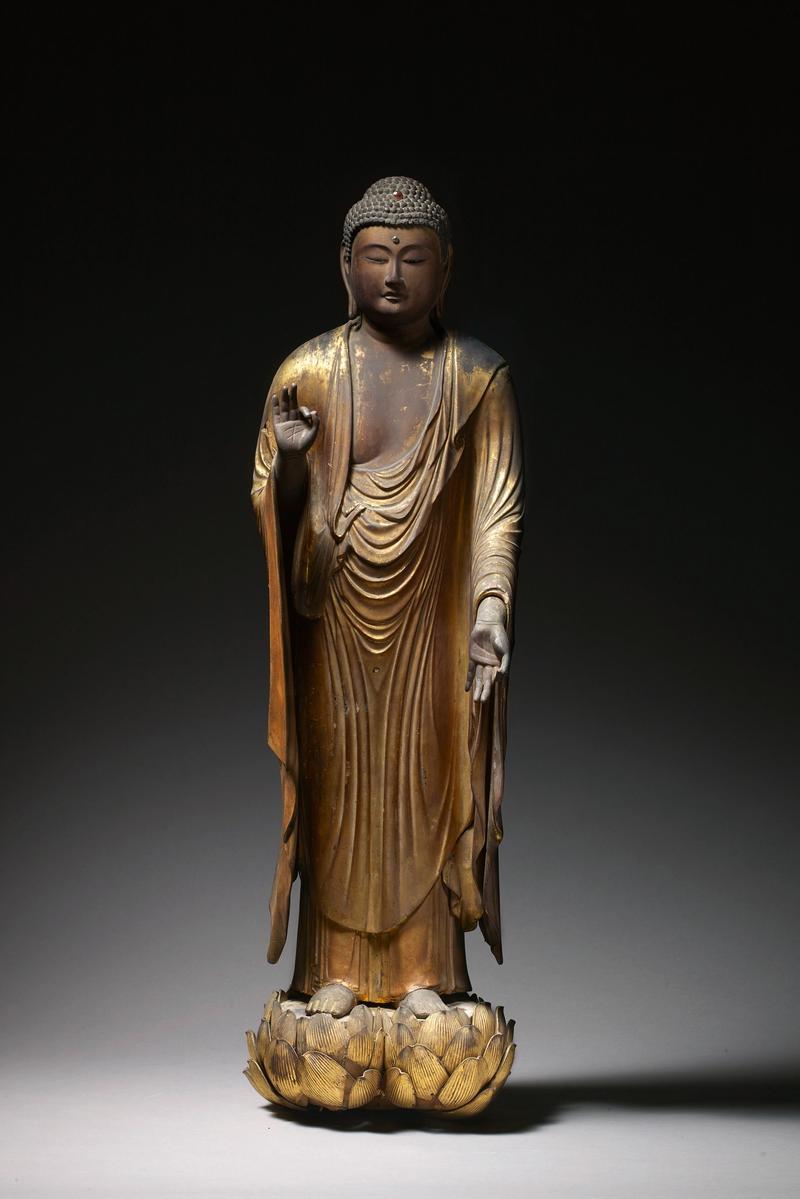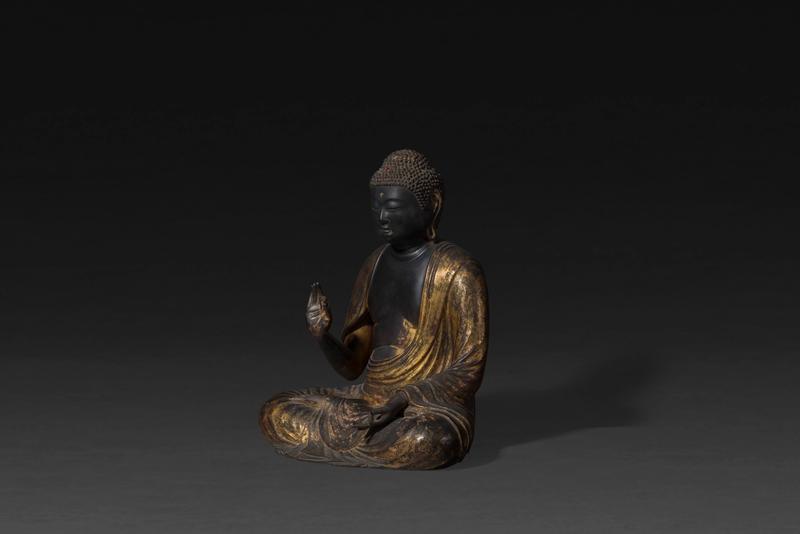A wood figure of Amida Nyorai, Heian/Kamakura period
#7686
H. 50cm x W. 43cm x D. 36cm (19½" x 17" x 14¼")
A lacquer and gilt wood figure of a seated Amida Nyorai (Amitābha) dressed in a flowing robe.
The head has gyokugan (inlaid crystal eyes) and is adorned with crystals representing the byakugō (white spiralling hair) on the forehead and the nikkei-shu (red jewel on the protrusion on top of the Buddha’s head). The right arm raised and the left arm extended with the forefinger and thumb of each hand forming a circle, which represents the raigōin mudra, welcoming the believer into Amida’s Great Western Paradise.
Japan, 12th/13th century, Heian/Kamakura period.
Provenance: Collection of Mrs. F. Perks, San Francisco, USA.
Purchased from Gump’s on 16th October 1965 and hence by decent to her daughter Mrs. J. Kedziora.
Accompanying documentation:
The original bill of sale and a copy of an appraisal letter (dated 26th Oct. 1965) showing the purchase price, an explanation of Buddhism and an expert opinion of this dating by Professor Yukio Yashiro (1890-1975), Director of the Institute for Art Research in Tokyo and Dr. Harold Sterne (1922-1977), Head Curator of Japanese Art at the Freer Gallery of Art, Washington D. C.
Old inscriptions inside the figure show signs of wear and are mostly illegible. However, they indicate that this figure was repaired after an accident and rededicated on the 16th August, in the 5th year of the Kansei era (1464).
The base bears a further inscription consisting of approximately a dozen names. Due to the high cost of producing Buddhist sculpture in this period, it was common for many donors to contribute to the construction of a single piece, giving them the opportunity to connect personally to a venerated Buddhist image. In particular in the Kinai area (ancient capital region), some regional feudal lords became donors for the construction of Buddhist sculptures from the 11th to 13th century and many Buddhist sculptures from this period with donors’ names are known.*
Belief in Amida as Lord of the Western Paradise rose in popularity during the late 10th century.Based primarily on the concept of salvation through faith, it was not only a religion appealing to a broad range of people, but also a direct assertion of piety against the dogmatic and esoteric ritual of the more traditional Tendai and Shingon sects. In Amida’s Western Paradise the faithful are reborn, to progress through various stages of increasing awareness until finally achieving complete enlightenment.
Another factor that engendered faith in Amida was a widespread belief of the Three Periods of the Law known as the Days of the Dharma (the Buddhist teachings). This was an all-encompassing concept of society’s rise and fall that originated in Indian Buddhism and later became widespread in China and Japan. It foretold of the world’s ultimate decay and the complete disappearance of Buddhist practice. At the time, the Days of the Dharma in Japan were divided into three periods. The first phase, the Age of Shōbō, was said to last 1000 years after the death of the Buddha. It was believed to be a golden period during which followers had the capacity to understand the Dharma. The second phase, the Age of Zōhō, was also to last 1000 years, during which Buddhist practice would begin to weaken. The third and final phase lasting 3,000 years, the Age of Mappō, was when Buddhist faith would deteriorate and no longer be practiced. In Japan the Age of Mappō was said to begin in 1052 AD, and a sense of foreboding thus filled the land, with people from all classes yearning for salvation leading to a widespread practice of continuously repeating the mantra of Amida Buddha.
For a similar example dated 1133 in the Zenmyoji temple, Shiga prefecture, see Miho Museum et al eds., Omi: Spiritual Home of Kami and Hotoke, exhibition catalogue, (Kyoto, 2011), p.192, 246, no. 15.
Buddhist Art

A kakemono with the monk Hōnen

A kakebotoke

Zenkoji Kannon Bosatsu

Buddhist wood panels

A wood figure of Amida Nyorai, Heian/Kamakura period

Kakebotoke of Bishamonten

Dainichi Nyorai

Amida Buddha

Daiarakan (Sacred Arhat)

Jizō Bosatsu

Amida Buddha

A silk kakemono with Kannon

An iron nyoi

Zushi with Kannon

A bronze kakebotoke of Kannon















